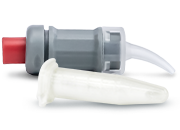
Sprig has been working along with the AAPD to obtain a specific code applicable to our pediatric zirconia crowns. We are proud to announce that the ADA has issued a new code: D2929. Specifically designated as a prefabricated porcelain/ceramic crown–primary tooth. We hope this new code will clarify your billing options and assist your office in providing the best possible service to your pediatric patients.
Maximizing reimbursement & minimizing risk.
The rationale for adding D2929: The prefabricated crown series (D2900-D2999) in CDT 2011-2012 did not provide a code for a ceramic substrate material. However, with the increasing shift to esthetic materials, the demand for esthetic anterior and posterior crowns for the primary dentition has followed suit.
The prefabricated zirconium crown for primary teeth is individually milled, but to a generic tooth preparation model rather than to a finished tooth preparation. In many respects, it is similar to the prefabricated stainless steel crown (D2930, D2931), the prefabricated resin crown (D2932), and the prefabricated stainless steel crown with resin window (D2934) in all but material (and some details of tooth prep and design).
The rationale for adding D2929: The prefabricated crown series (D2900-D2999) in CDT 2011-2012 did not provide a code for a ceramic substrate material. However, with the increasing shift to esthetic materials, the demand for esthetic anterior and posterior crowns for the primary dentition has followed suit.
Since the material is porcelain/ceramic, some dental practices have reported this procedure as D2740. However, the D2700-D2799 series is reserved for custom fabricated crowns, so a new code was needed specifically for a porcelain/ceramic prefabricated crown for a primary tooth, effective in January 2013.


